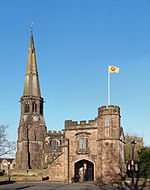
Anfield Cemetery, or the City of Liverpool Cemetery, is located in Anfield, a district of Liverpool, Merseyside, England. It lies to the northeast of Stanley Park, and is bounded by Walton Lane to the west, Priory Road to the south, a railway line to the north, and the gardens of houses on Ince Avenue to the east. The cemetery grounds are included in the National Register of Historic Parks and Gardens at Grade II*.

Widnes is an industrial town in the Borough of Halton, Cheshire, England, on the north bank of the River Mersey where it narrows at Runcorn Gap. The town contains 23 buildings that are recorded in the National Heritage List for England as designated listed buildings. Of these, 5 are classified at Grade II*, and 18 at Grade II; Widnes has no Grade I listed buildings. In the United Kingdom, the term "listed building" refers to a building or other structure officially designated as being of special architectural, historical, or cultural significance. Listed buildings are categorised in three grades: Grade I consists of buildings of outstanding architectural or historical interest; Grade II* includes particularly significant buildings of more than local interest; Grade II consists of buildings of special architectural or historical interest. Buildings in England are listed by the Secretary of State for Culture, Media and Sport on recommendations provided by English Heritage, which also determines the grading.
Liverpool is a city and port in Merseyside, England, which contains many listed buildings. A listed building is a structure designated by English Heritage of being of architectural and/or of historical importance and, as such, is included in the National Heritage List for England. There are three grades of listing, according to the degree of importance of the structure. Grade I includes those buildings that are of "exceptional interest, sometimes considered to be internationally important"; the buildings in Grade II* are "particularly important buildings of more than special interest"; and those in Grade II are "nationally important and of special interest". Very few buildings are included in Grade I — only 2.5% of the total. Grade II* buildings represent 5.5% of the total, while the great majority, 92%, are included in Grade II.
Liverpool is a city and port in Merseyside, England, which contains many listed buildings. A listed building is a structure designated by English Heritage of being of architectural and/or of historical importance and, as such, is included in the National Heritage List for England. There are three grades of listing, according to the degree of importance of the structure. Grade I includes those buildings that are of "exceptional interest, sometimes considered to be internationally important"; the buildings in Grade II* are "particularly important buildings of more than special interest"; and those in Grade II are "nationally important and of special interest". Very few buildings are included in Grade I — only 2.5% of the total. Grade II* buildings represent 5.5% of the total, while the great majority, 92%, are included in Grade II.
Liverpool is a city and port in Merseyside, England, which contains many listed buildings. A listed building is a structure designated by English Heritage of being of architectural and/or of historical importance and, as such, is included in the National Heritage List for England. There are three grades of listing, according to the degree of importance of the structure. Grade I includes those buildings that are of "exceptional interest, sometimes considered to be internationally important"; the buildings in Grade II* are "particularly important buildings of more than special interest"; and those in Grade II are "nationally important and of special interest". Very few buildings are included in Grade I — only 2.5% of the total. Grade II* buildings represent 5.5% of the total, while the great majority, 92%, are included in Grade II.

Christ Church is in Ince Green Lane, Lower Ince, Ince-in-Makerfield, Greater Manchester, England. It is an active Anglican parish church in the deanery of Wigan, the archdeaconry of Warrington, and the diocese of Liverpool. Its benefice is combined with that of St Catharine, Wigan. The church is recorded in the National Heritage List for England as a designated Grade II listed building.
Ince Blundell is a civil parish and a village in Sefton, Merseyside, England. It contains 24 buildings that are recorded in the National Heritage List for England as designated listed buildings. Of these, five are listed at Grade II*, the middle of the three grades, and the others are at Grade II, the lowest grade.
Burscough is a civil parish in the West Lancashire district of Lancashire, England. It contains 38 buildings that are recorded in the National Heritage List for England as designated listed buildings. Of these, two are at Grade II*, the middle grade, and the others are at Grade II, the lowest grade. The parish contains the large village of Burscough, the rural hamlet of Tarlscough, and the surrounding countryside. Passing through the parish is the Leeds and Liverpool Canal, and the junction between the canal and its Rufford Branch is in the parish. Also passing through the parish are the railways of the Ormskirk - Preston and the Manchester-Southport Lines, which cross in the parish. The oldest listed buildings are farmhouses and farm buildings, and houses and cottages. Associated with the canal are the structures at the junction, bridges and a lock. Associated with the railways are station buildings and a bridge. The other listed buildings include churches, a war memorial, and a former mill and its offices.
Downholland is a civil parish in the West Lancashire district of Lancashire, England. It contains eight listed buildings that are recorded in the National Heritage List for England. All the listed buildings are designated at Grade II, the lowest of the three grades, which is applied to "buildings of national importance and special interest". The parish contains the villages of Barton, Haskayne and Downholland Cross, and is otherwise rural. The Leeds and Liverpool Canal passes through the parish. Two milestones by the towpath of the canal are listed, and the other listed buildings are houses and associated structures.
Lathom is a civil parish in the West Lancashire district of Lancashire, England. It contains 49 buildings that are recorded in the National Heritage List for England as designated listed buildings. Of these, one is at Grade II*, the middle grade, and the others are at Grade II, the lowest grade. The parish contains the village of Lathom, and is otherwise rural. The most important building in the parish is Latham House, but most of this has been demolished, leaving only part of one wing. This is listed, together with structures associated with it. The Leeds and Liverpool Canal and its Rufford branch run through the parish, and the associated listed structures include culverts, locks and bridges. There are also three former railway level crossing keeper's cottages built for the Manchester and Southport Railway. Because of its rural nature, many of the listed buildings are farmhouses and farm buildings. The other listed buildings include a chapel, almshouses, other bridges, houses and associated structures, lodges, a war memorial, and a school.
Newburgh is a civil parish in the West Lancashire district of Lancashire, England. It contains 37 buildings that are recorded in the National Heritage List for England as designated listed buildings. Of these, one is at Grade II*, the middle grade, and the others are at Grade II, the lowest grade. The parish contains the village of Newburgh and surrounding countryside. Most of the listed buildings are houses, farmhouses and farm buildings. The Leeds and Liverpool Canal and the River Douglas run through the parish, and associated with these are aqueducts and a culvert. The other listed buildings include a village cross, a public house, a post office, a war memorial, and a telephone kiosk.
Wrightington is a civil parish in the West Lancashire district of Lancashire, England. It contains 35 buildings that are recorded in the National Heritage List for England as designated listed buildings. Of these, four are at Grade II*, the middle grade, and the others are at Grade II, the lowest grade. The parish is mainly rural, and contains the village of Appley Bridge and the community of Wrightington Bar. A high proportion of the listed buildings in the parish are houses or cottages and associated structures, or farmhouses and farm buildings. The Leeds and Liverpool Canal runs though the parish and two of its locks are listed. The other listed buildings include churches, a school, a bridge, and a milestone.
Haigh is a civil parish in the Metropolitan Borough of Wigan, Greater Manchester, England. It contains 30 listed buildings that are recorded in the National Heritage List for England. Of these, one is listed at Grade II*, the middle grade, and the others are at Grade II, the lowest grade. The parish contains the village of Haigh, the estate of Haigh Hall, and the surrounding countryside. The most important building in the parish is Haigh Hall; this and a number of buildings in the estate are listed. The Leeds and Liverpool Canal runs through the parish, and three bridges associated with it are listed. The other listed buildings include farmhouses, farm buildings, a set of stocks, houses, workers' cottages, a church and associated structures, a school, and a bridge over a disused railway.
Shevington is a civil parish in the Metropolitan Borough of Wigan, Greater Manchester, England. The parish contains eight listed buildings that are recorded in the National Heritage List for England. All the listed buildings are designated at Grade II, the lowest of the three grades, which is applied to "buildings of national importance and special interest". The parish contains the villages of Shevington and Gathurst and the surrounding countryside. The Leeds and Liverpool Canal passes through the parish, and the listed buildings associated with is are a bridge, locks, and a lock-keeper's cottage. The other listed buildings are a farmhouse, farm buildings, a public house with a mounting block, and a school and master's house.
Ashton-in-Makerfield is a town in the Metropolitan Borough of Wigan, Greater Manchester, England. It contains ten listed buildings that are recorded in the National Heritage List for England. All the listed buildings are designated at Grade II, the lowest of the three grades, which is applied to "buildings of national importance and special interest". Industry, including coal mining, came to the town in the 19th century, but it is now mainly residential. The older listed buildings consist of farmhouses, a farm building, a chapel and a milestone, and the later ones are churches and associated structures, and a library.
Aspull is a village in the Metropolitan Borough of Wigan, Greater Manchester, England. The village and the surrounding countryside contain 21 listed buildings that are recorded in the National Heritage List for England. Of these, one is listed at Grade II*, the middle of the three grades, and the others are at Grade II, the lowest grade.
Billinge and Winstanley is an area in the Metropolitan Borough of Wigan, Greater Manchester, England. The area, which consists of small settlements and surrounding countryside, includes eleven listed buildings that are recorded in the National Heritage List for England. Of these, three are listed at Grade II*, the middle of the three grades, and the others are at Grade II, the lowest grade. Most of the listed buildings are houses and associated structures, the others being monuments and a set of stocks.
Leigh is a town in the Metropolitan Borough of Wigan, Greater Manchester, England. The town, together with its suburbs of Bedford, Westleigh and Pennington, contains 33 listed buildings that are recorded in the National Heritage List for England. Of these, four are listed at Grade II*, the middle of the three grades, and the others are at Grade II, the lowest grade.
Wigan is a town in the Metropolitan Borough of Wigan, Greater Manchester, England. The town, together with the suburbs of Pemberton, Scholes, Whelley, Worsley Mesnes, Winstanley, and Goose Green, contains 125 listed buildings that are recorded in the National Heritage List for England. Of these, nine are listed at Grade II*, the middle of the three grades, and the others are at Grade II, the lowest grade.

















